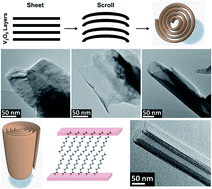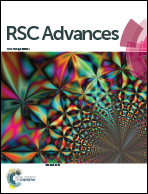Optimizing the structure and yield of vanadium oxide nanotubes by periodic 2D layer scrolling†
Abstract
Metal oxide nanotubes with wide interlayer van der Waals spaces are important materials for a range of applications from energy storage to catalysis, and from energy efficient catalysts and metal–insulator systems to smart window technologies. Controlling the crystalline quality is critical for the material's physical properties on the nanoscale. We report a systematic investigation into the optimization of structural quality and yield of vanadium oxide nanotubes (VONTs) synthesized by hydrothermal treatment. Usually, interdigitation of alkyl-amine chains occurs between V2O5 lamina, a stitching process that allows scrolling of 2D crystalline sheets into nanotubes with consistently high quality. Through detailed microscopy and spectroscopy examination, we demonstrate that two amine molecules per V2O5 unit optimizes the structure, quality and yield of the VONTs, and that uniform coverage of the juxtaposed V2O5 surfaces in the interlayer spacing minimizes non-uniformities and defects. This observation is consistent for a range of primary amine lengths (hexylamine to hexadecylamine). Through statistical investigation of hundreds of VONTs under each condition, we uncover the effect of amine chain length of V2O5 2D sheet thickness, and mechanism for optimum VONT quality. Finally, we summarize non-uniformities during VONT synthesis including, bending, spiraling and twisting of the scrolled crystalline layers.


 Please wait while we load your content...
Please wait while we load your content...